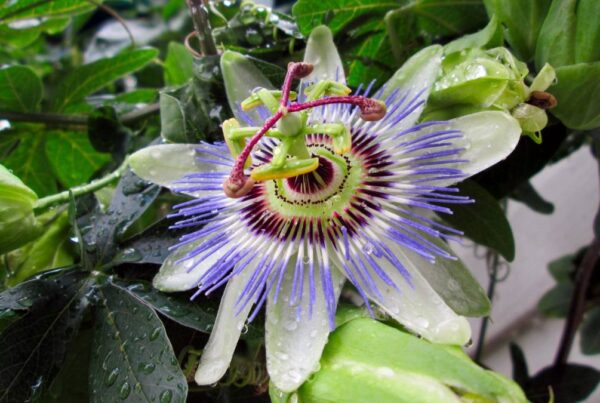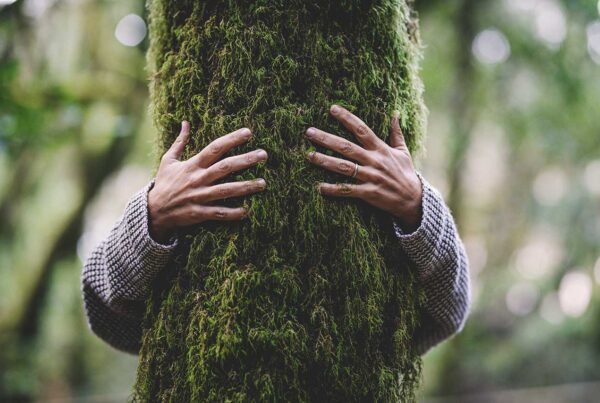One in five Americans suffers from some form of mental health issues, and this number was only exacerbated by the Covid-19 pandemic that uprooted everyone’s lives.
Another growing problem in America culture (and seen throughout highly-developed countries) is how sedentary people have become with the average person sitting and staring at screen for over 10 hours a day and the typical child spending less than an hour a day outside.
The stark reality is that no pill, supplement or food can make up for such a sedentary way of life because it goes against our evolutionary biology and our body’s physiological need for movement and exercise.
Perhaps the antidote to today’s sedentary lifestyle and mental health epidemic is ecotherapy, where people spend more time outside walking, hiking and unplugging from their screens to enjoy the beauty of the natural world.
Mindfulness-Based Ecotherapy And Nature Connection
While most therapy focuses on talking, language and works mostly above the neck, mindfulness-based ecotherapy involves re-building an embodied connection to the world around you.
A simple mindfulness-based ecotherapy practice to get started with is grounding.
One of the reasons for the high levels of stress and anxiety in the highly-developed countries is that people aren’t grounded to the Earth.
When was the last time you were barefoot and the soles of your feet touched the ground? For many people today, they go months without touching their feet to the ground.
Grounding is a simple practice with huge benefits such as reducing inflammation, boosting the immune response, wound healing, and the prevention and treatment of chronic inflammatory and autoimmune diseases [1].
Other benefits include better sleep, lower anxiety and reduced pain, and all you have to do is walk barefoot outside or practice sitting, working, or sleep indoors in a environment connected to conductive systems that transfer the Earth’s electronics from the ground into the body [2].
While much of modern psychology and therapy works from the neck upwards, Mindfulness-Based Ecotherapy is focused on going beyond the labelling, judgements and identifications of the mind and feeling your experience deeper in the felt presence of the body.
Next time you have a chance, try a grounding exercise for yourself. Take off your shoes somewhere you can comfortably like the beach, a forest trail or a grassy field and explore how sensitive the bottom of your feet are to the touch of the Earth.
Spend 10-15 minutes mindful walking barefoot and just observe as your feet press against the Earth with each step.
I’m sure you’ll be surprised afterwards to experience how much lighter and more relaxed you feel after just a short session of grounding.
When The Culture Is Sick, We Need To Go Back To Our Roots

As climate change advances and the growth-obsessed societies of the Western world continue their economic decline as debt levels become unsustainable, there will be a growing longing to reconnect to something that is timeless and enduring in a meaningless, disposable consumerist world.
At the root of our ecological crisis and our spiritual discontent is our alienation from nature.
In mindfulness-based Ecotherapy, you can incorporate the philosophy of animism where you experience everything is alive and possessed by a living spirit, which can help you deeper tune into felt presence through increasing embodied presence and expanding your feeling sense.
Animism is about a direct and personal experience with the more-than-human world. As children, we naturally heard the living voice of nature speaking to us through our senses and how the living world makes us feel alive.
In many ways, an animistic view of life is the antithesis of the Western training of the mind in its left-hemisphere analytical dominance and hyper-rationality.
Separated from nature and the living, feeling presence of the body that we are taught to distrust, we are told there is little to do but pursue pleasure and security through the 3 base emotions that drive the modern world through the 1000s of advertisements we are exposed to each day: greed, lust and envy.
This industrial economic engine of advertising, consumption and materialism serves to satisfy the spiritual hunger that is left by our abstract, mechanistic and empty form of empiricism.
Mindfulness-Based Ecotherapy is involves going beyond conceptualized thinking to a direct experience of the “felt presence” of a living, breathing world.
Rather than analyzing and arguing with ourselves, we can gain much by relaxing and tuning into our senses and let go of our pre-conceptions and constant chattering of the thinking mind.
Less thinking makes us more aware and more connected, and helps us ground ourselves in our emotional felt experience, which when shared with others in our community can be incredibly healing.
So, to summarize, Mindfulness-Based Ecotherapy is about cultivating a reverence and felt sense of awe for the miracle of life and build a sense of belonging as an integral part of the Earth community.
10 Ecotherapy Practices That Can Improve ADHD, Depression And Stress Management
Here are some of the best ecotherapy practices for improving both physical and mental health:
1. Animal-Assisted Ecotherapy
Animal-assisted ecotherapy involves human-animal interactions and building a relationship bond with animals.
Adopting a dog or cat, for example, has been found to significantly decrease stress levels, anxiety and depression [3].
2. Horticultural Therapy
Horticultural therapy involves practices that use plants and garden to improve mental and physical health. Simply getting your hands dirty has been found to improve mood and well-being because soil bacteria has been found to work in a similar way to antidepressants.
This form of gardening ecotherapy has been found effective in increasing mental well-increased, a deeper sense of meaning and an improved sense of resilience and emotional intelligence [4].
3. VR Nature Therapy:
Wasn’t I just talking about too much screentime? Well, it seems that virtual reality simulations of the natural world cam also be effective for improving mental health.
A series of studies have found that designing convincing and realistic settings that provide the user with a feeling of actually being present in the virtual environment can help improve mental well-being [5].
4. ADHD Ecotherapy:
Nature connected therapy practices have been shown to be especially effective for both children and adults with ADHD.
Author Richard Louv of the landmark book Last Child In The Woods even goes as far as to argue that is ADHD is actually Nature Deficit Disorder and people with ADHD need more exercise, nature connection and outdoor activities to engage their attention.
There has been significant research done on Attention Restoration Therapy studying the effect on walking in the forests on improving attention and decreasing stress [6].
Ecotherapy for ADHD can simply mean doing an extra 30 minutes of walking per day and dedicating half day or full day a week to unplugging and recharging in nature.
5. Forest Therapy and Shinrin-Yoku
There has been significant research done in Japan and South Korea studying how prescribed weekly forests walking improve both physical and mental health.
Shinrin-Yoku (the Japanese art of Forest Bathing) has become a popular way to reconnect with the natural world and induce states of relaxation and connectedness [7].
6. Ecotherapy For Depression And Anxiety
Ecotherapy is an emerging form of treatment that can help with healing depression. Research on ecotherapy shows that nature helps to alleviate stress, anxiety, depression, and can even improve memory [8].
A recent study found that physical activity was 1.5 times more effective than prescription antidepressants or counselling therapy [9].
7. Ecotherapy For Stress Management
Mindfulness has been found to be one of the most effective daily practices for stress management and increasing emotional intelligence (self-regulation).
One of the best ecotherapy practices for reducing depression, anxiety and stress is gardening. The combination of physical activity, social contact and being surrounded by nature is thought to make gardening beneficial for our mental health [10].
8. Adventure Therapy:
Adventure therapy is an outdoor activity such as hiking, camping, rock climbing, kayaking or paddleboarding. The idea is to become immersed in the experience of exploring nature and really get out there and explore (maybe even get lost for awhile).
So much of our lives these days are routine and predictable, adventure therapy can be helpful to break out of a boring routine and do a challenging activity can that aid in a therapeutic healing process.
9. Mindful Stargazing
There has been extensive research done on the emotion of awe by the Berkley Greater Good Science Center. One of the most potent triggers for awe is the mindful practice of stargazing.
A study on stargazing ecotourism found that it induced peak experiences in participants and reduced their stress and anxiety levels [11].
10. Mindful Birdwatching
Another interesting form of ecotherapy is mindful birdwatching. Listening to bird songs and watching the actions of birds in the environment is an effortless way to practice mindfulness.
Birdwatching has found to have numerous mental health benefits. A 2017 study published in BioScience, scientists from England’s University of Exeter found that when people witnessed more birds in their daily lives, they experienced reduced prevalence and severity of stress, depression and anxiety [12].
Creating Your Own Ecotherapy Practice:
The easiest way to start an ecotherapy practice to improve your physical and mental health is set a goal to take an extra 20-30 minute walk each day and spend at least 2-3 hours unplugged hiking each week.
Try some of the ecotherapy practices mentioned here and incorporate different activities to keep it fun and interesting!
- 10 Sustainable Travel Trends Driving The Future of Tourism - March 9, 2025
- 10 Tips To Sell Out Your Transformational Retreats In 2025 - February 20, 2025
- Build 10 Habits That Free Up Your Time With Mindful Coaching - February 11, 2025





